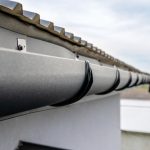
Gutters play a vital role in protecting your home from water damage by directing rainwater away from the roof and foundation. However, they are not immune to common problems like rust, sagging, and overflowing. In this article, we’ll explore practical solutions to address these issues, ensuring the longevity and effectiveness of your gutter system.
1. Rust: Protecting Your Gutters from Corrosion
Rust is a common challenge for metal gutters, especially those made from steel and iron. Over time, exposure to moisture and the elements can compromise the structural integrity and appearance of your gutters. Here’s how to deal with rust:
- Regular Inspection: Conduct regular inspections to spot rust early. Look for signs such as peeling paint or visible rust on the gutter’s surface.
- Clean and Prepare: Use a wire brush to remove loose rust and debris from affected areas. This step is crucial in preparing the surface for further treatment.
- Apply Rust Converter: To stop further corrosion, apply a rust converter to the affected areas. This product chemically converts rust into a stable compound, preventing it from spreading.
- Protect with Rust-Resistant Paint: Once the rust converter has dried, paint the gutter with rust-resistant paint. This additional layer acts as a shield against future rust formation, extending the life of your gutters.
2. Sagging: Ensuring Proper Alignment and Support
Sagging gutters can result from debris accumulation, ice, standing water, or improper installation. Addressing this issue is essential for maintaining the effectiveness of your gutter system:
- Regular Cleaning: Clean your gutters regularly to prevent debris buildup, reducing the risk of sagging.
- Adjust Slope: Ensure a slight decline towards the downspout to facilitate proper water drainage.
- Inspect Hangers and Brackets: Check the condition of the hangers and brackets holding the gutter to the fascia board. Replace or repair any that are loose or damaged.
- Enhance Support: Consider installing additional hangers or brackets to provide extra support, preventing sagging over time.
3. Overflowing: Prevention is Key
Overflowing gutters can lead to significant damage to your home’s foundation and landscaping. Taking proactive steps to prevent clogs is crucial:
- Regular Cleaning: The most effective way to prevent overflowing is regular gutter cleaning. Remove leaves, twigs, and debris to maintain a clear passage for water flow.
- Gutter Guards or Leaf Screens: Install gutter guards or leaf screens to prevent debris from entering the gutter system in the first place.
- Clear Downspouts: Check the downspouts for clogs and use a plumber’s snake or hose to clear any blockages, ensuring unobstructed water flow.
- Correct Slope: Confirm that the gutters are correctly sloped toward the downspout to promote proper drainage and prevent overflow.
Maintaining Gutters for Longevity and Effectiveness
Regular inspections and proactive maintenance play a crucial role in extending the life and effectiveness of your gutter system. By addressing issues like rust, sagging, and overflowing promptly, you can safeguard your home from water damage. In cases where problems are extensive, seeking professional advice for gutter repair or replacement is recommended.
Leafguard: A Solution to Common Gutter Problems
With Leafguard, you can eliminate concerns about rust, sagging, and overflowing. Crafted from aluminum, Leafguard is rust-resistant and 20% stronger than standard gutters, ensuring durability and reliability. Additionally, Leafguard is guaranteed never to clog, providing a hassle-free solution to gutter maintenance. Invest in Leafguard today and enjoy peace of mind, knowing your home is protected for life.
Contact us today more information!




